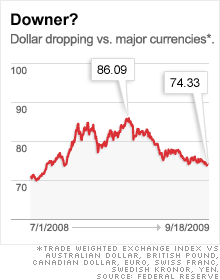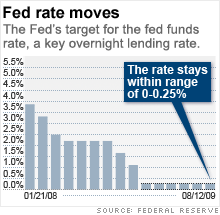The Fed's dollar conundrum
The central bank has flooded the world with dollars to avert collapse and start a recovery. But what if the U.S. economy doesn't reap the rewards?


NEW YORK (Fortune) -- Whose recovery is the Fed stimulating, anyway?
A year after the near collapse of the financial markets, the global economy has stabilized. Job losses have slowed and stocks have posted a sharp rally.
Yet skeptics warn that a major driver of the recovery in stock and bond markets -- a round of unprecedented emergency money printing by the Federal Reserve -- could actually slow the healing of the real economy.
In this view, the Fed's decision to hold short-term interest rates near zero has temporarily revived financial markets without addressing the economy's underlying problems. The danger is that with bank lending remaining anemic and consumer balance sheets still bloated, the low U.S. rates could end up supporting overseas growth without fortifying domestic health.
"You end up financing everybody else's expansion but your own," said Howard Simons, a strategist at Bianco Research in Chicago.
Critics focus on the fact that low U.S. interest rates enable investors around the globe to borrow dollars for next to nothing and invest them elsewhere at higher rates.
This bet -- known as the dollar carry trade -- appears to be one of the forces pushing down value of the dollar. Though there are few reliable figures on the size of the carry trade, the dollar's trend has clearly been down since stock and bond markets revived.
The buck recently traded at its lowest level against the euro in a year, while the trade-weighted dollar index has dropped 14% since March.
The resulting investment flows are potentially unstable, prompting talk of new asset price bubbles -- particularly in commodities such as oil and gold, and the economies of faster-growing emerging markets.
That sounds like an unpleasant arrangement, but Americans may have to get used to it. The Fed, which is expected to hold interest rates steady when it wraps up a two-day meeting Wednesday, has said it anticipates keeping its fed funds rate near zero for an extended period.
That could mean months of a currency-depressing, growth-stunting carry trade -- an echo of Japan's experience during two decades of on-again, off-again zero interest rates.
Of course, the world was a different place then. In the 1990s and the early part of this decade, other rich countries were showing solid growth. Now, other governments -- notably the U.K. -- are following essentially the same spending playbook as the U.S.
"Everyone's doing the same stupid thing now," said Simons. "If everyone's being irresponsible, you end up in a race to be most irresponsible."
None of this means that Fed chief Ben Bernanke and other policymakers had lots of better options at their disposal when they took rates down to zero and began buying bonds in a bid to make credit more available.
The financial sector was on the verge of cataclysm after years of easy money policies led to a surge of bad loans and a flight of capital from wholesale funding markets. Facing a total meltdown, officials enacted programs that supported the mortgage market and stabilized the banking system.
That those decisions were costly and have contributed to soaring government spending is obvious. But without them, the U.S. could have faced a replay of the Great Depression, when unemployment was above 20%.
"How much worse ... would conditions for the average American have been without that handout?" says Tim Duy, an economics professor at the University of Oregon. "That is the relevant question."
Still, the debate over who is reaping the biggest benefits from the financial rescue is hardly a new one.
Most prominently, Goldman Sachs (GS, Fortune 500) -- the securities firm that received $10 billion of Treasury capital last fall under the Troubled Asset Relief Program and has since issued almost $22 billion of government-backed debt -- has rebounded so strongly that it's on pace to pay bonuses on par with those of the boom years.
Meanwhile, two forms of credit creation most relevant to consumers and small businesses -- securitization and bank lending -- have yet to bounce back. Consumer credit dropped at a 10.5% annual rate in July, the Federal Reserve said, and commercial bank loans fell at a $392 billion annual rate in the second quarter.
These are not the makings of a vigorous domestic recovery, said Michael Pento, chief economist at investment adviser Delta Global Advisors.
"The people looking for a V-shaped recovery are living in Candyland," he said. "One of these days we're going to have to stop trying to inflate our way out." ![]()
-
 The retail giant tops the Fortune 500 for the second year in a row. Who else made the list? More
The retail giant tops the Fortune 500 for the second year in a row. Who else made the list? More -
 This group of companies is all about social networking to connect with their customers. More
This group of companies is all about social networking to connect with their customers. More -
 The fight over the cholesterol medication is keeping a generic version from hitting the market. More
The fight over the cholesterol medication is keeping a generic version from hitting the market. More -
 Bin Laden may be dead, but the terrorist group he led doesn't need his money. More
Bin Laden may be dead, but the terrorist group he led doesn't need his money. More -
 U.S. real estate might be a mess, but in other parts of the world, home prices are jumping. More
U.S. real estate might be a mess, but in other parts of the world, home prices are jumping. More -
 Libya's output is a fraction of global production, but it's crucial to the nation's economy. More
Libya's output is a fraction of global production, but it's crucial to the nation's economy. More -
 Once rates start to rise, things could get ugly fast for our neighbors to the north. More
Once rates start to rise, things could get ugly fast for our neighbors to the north. More







